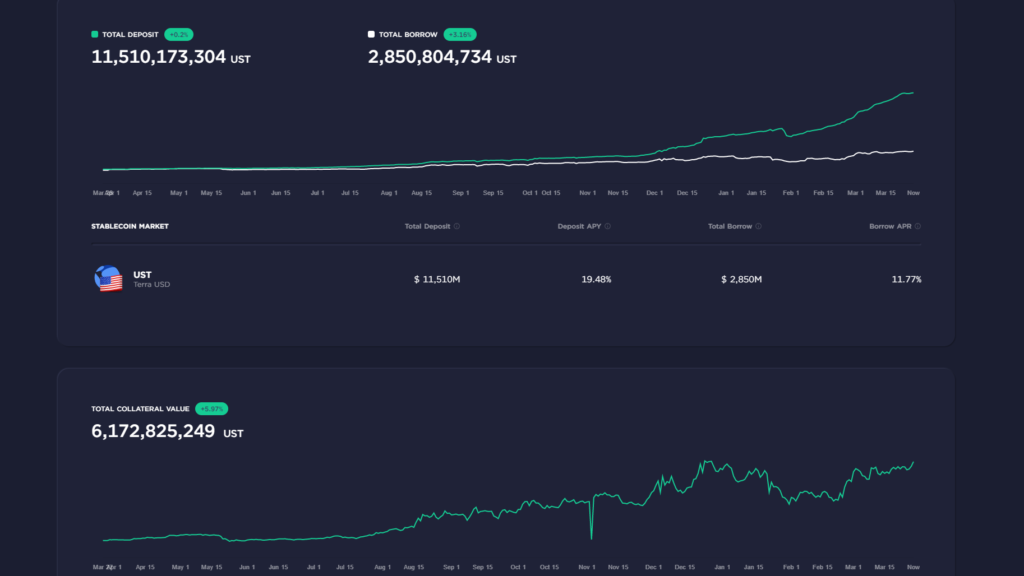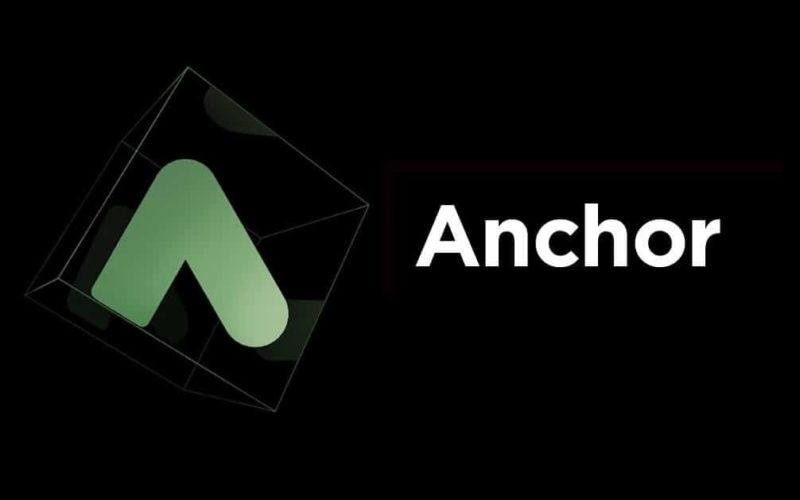Anchor Protocol is therefore a decentralized protocol on the Terra blockchain that allows, among other things, to generate interest on your USTs (algorithmic stablecoin of the Terra ecosystem).
The rate of about 19.5% per year promised by Anchor, has allowed the entire Terra ecosystem to grow by democratizing its UST stablecoin, itself increasing the buying pressure of the Luna token.
However, the protocol, like many popular DeFi systems, is a victim of its own success. Degenboxes are being created, and many investors are looking for ingenious (but risky) ways to increase their interest rate using leverage systems. These practices dramatically increase the total value locked up (TVL) in the protocol, to over $17 billion, according to the web application. The overwhelming majority of these funds are placed in the yield, with a small portion generating revenue to feed the system.
Indeed, Anchor also offers a lending service, unfortunately not used enough for the moment.

The Luna Foundation as well as Terraform Labs (the parent company of the Terra blockchain) rely heavily on the Anchor protocol and its ability to attract large numbers of users into the ecosystem. Both then adopted this effective short-term strategy by bailing out themselves as needed.
More than $1 billion has already been added to the pool deploying interest to USTs deposited in the protocol. Despite this, the reserve continues to be depleted at an increasing rate and the community has decided to reduce the return on the protocol. The “Prop 20” proposal made on the Anchor Governance Forum was adopted on March 24.
The new Anchor rate of return variation system
The stable rate of return that the Anchor protocol is known for is gone, replaced by the dynamic rate of return.
The accepted proposal provides for an increase or decrease in the interest rate depending on the state of the reserve. Simply put, if the reserve continues to be depleted, the interest rate will decrease. On the other hand, when the reserve fills up, the interest rate increases.
The proposal provides for a maximum movement of 1.5% in the interest rate, which means that the rate cannot go down or up by more than 1.5% per month.
Amendment: Anchor Protocol has decided to add caps on the rate of return with a minimum of 15% and a maximum of 20%.
If the value in the reserve decreases by more than 1.5% from month to month, then the interest rate on Anchor will be reduced by 1.5%. If the reserve loses 0.5% over a month, the rate of return will be reduced by 0.5% as well.
Example over a few months:
- March, interest rate = 19.5%: reserve decreases by 6% → 1.5% decrease in rate
- April, interest rate = 18%: the reserve decreases by 4% → 1.5% decrease in rate
- May, interest rate = 16.5%: the reserve decreases by 2.5% → 1.5% decrease in rate
- June, interest rate = 15%: reserve decreases by 0.5% → rate maintained (15% minimum)
- July, interest rate = 15%: the reserve increases by 1% → 1% increase in the rate
- August, interest rate = 16%: reserve increases by 3% → 1.5% increase in rate…
Decreasing the interest rate could stabilize and perpetuate the Anchor protocol while the rewards would be lower, but also thanks to a potential decrease in demand that would automatically regulate the rate.
Feedback from the community is mixed. According to some users, the entire protocol was based on its stable rate, which is very difficult to find elsewhere. It is true that this 19.5% promise was never kept, since the protocol could not operate at its full potential for a full year. Others are pleased with this decision, believing that the risks to the stability of the UST and the Luna token became too great if the reserve fell significantly.
It is difficult to imagine exactly what interest rates will be offered on Anchor in the coming months, but looking at the current state of the reserve, a decrease of 1.5% each month seems likely for some time.




